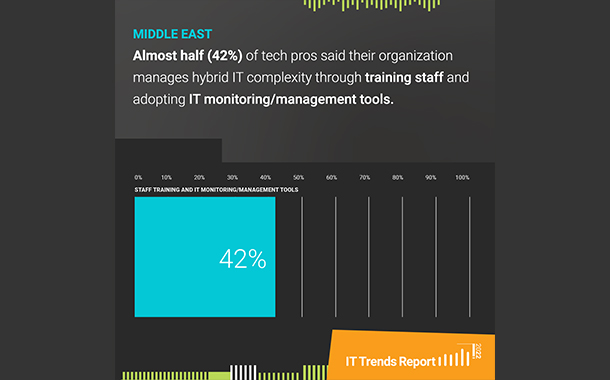SolarWinds released findings of its ninth annual IT Trends Report today. This year’s report, The SolarWinds IT Trends Report 2022—Getting IT Right: Managing Hybrid IT Complexity, examines the acceleration of digital transformation efforts and its impact on IT departments. The report found the acceleration of hybrid IT has increased network complexity for most organizations and caused several worrisome challenges for IT professionals.
Hybrid and remote work have amplified the impact of distributed and complex IT environments. Running workloads and applications across both cloud and on-premises infrastructure can be challenging, and many organizations are increasingly experiencing—and ultimately hindered by—these pain points. According to a report by IDC, as more and more mission-critical workloads move to connected cloud architectures that span public, private, hybrid, and multi-cloud environments, enterprises recognize they need to invest in the tools that will help them ensure consistent policies and performance across all platforms and end users. However, they simultaneously face challenges such as budget, time constraints, and barriers to implementing observability as a strategy to keep pace with hybrid IT realities.
The new SolarWinds report also found tech professionals feel less confident in their organization’s ability to manage IT. While nearly half (42%) of tech pro respondents state they leverage monitoring strategies to manage this complexity, 58% revealed they lack visibility into the majority of their organization’s apps and infrastructure. This lack of visibility impacts their ability to conduct anomaly detection, easy root-cause analysis, and other critical processes to ensure the availability, performance, and security of business-critical applications.
“Operational complexity prevents organizations from capitalizing on their technology-driven transformation and investments and delivering benefits for end users,” said Sudhakar Ramakrishna, president and CEO, SolarWinds. “As organizations look beyond the pandemic, they must re-examine their investments from the past few years. Part of that requires organizations to have visibility into their IT environments to understand what’s working and not working, and where to prioritize their efforts to achieve the ROI targeted in their planned projects.”
“Observability is increasingly becoming the clear answer for tech pros charged with managing greater levels of complexity in these diverse and distributed environments spanning on-premises, private and public clouds,” added Ramakrishna. “However, organizations must set aside time and resources to upskill and train tech pros to help them properly implement observability strategies and manage hybrid IT realities more effectively—and set up their teams and business for success in the long run.”
2022 Key Findings
The continued expansion to hybrid IT is driving increased levels of IT management complexity, but tech pros feel a lack of confidence in how to best manage it.
- One in five (20%) responded the acceleration of hybrid IT has increased the complexity of their organization’s IT management.
- These tech pros reported the following top drivers of increased complexity:
- Inefficient change management processes (60%)
- Outdated staff skillsets no longer aligned with new technologies (40%)
- Increased technology requirements from multiple departments (40%)
- New tools and/or technologies (35%)
- Interestingly, 50% of small businesses indicated outdated staff skillsets no longer aligned with new technologies as the leading cause for increased complexity, compared to 22% of their mid-size and 57% of their enterprise counterparts.
- When asked about how confident tech pros were in their organization’s ability to manage IT complexity:
- 24% of tech pro respondents said they felt extremely confident
- More than a third of respondents (27%) admitted they weren’t fully equipped to manage complexity and felt only somewhat confident
- 36% of tech pro respondents were confident their organization is equipped to manage IT complexity adequately
- 10% weren’t confident at all
- When tech pros’ level of confidence is considered by business size, confidence levels increased among enterprise respondents:
- Nearly six out of 10 (59%) small business tech pro respondents said they’re confident (50%) or extremely confident (9%) in managing IT complexity
- However, large enterprises experienced the highest level of confidence, with 29% of respondents saying they’re confident and 37% saying they’re extremely confident.
A particular area of concern among respondents is visibility. With the increased shift to complex, hybrid IT environments, technology professionals say they have limited visibility into their networks, apps, and infrastructure.
- When asked about current IT monitoring/management strategies, 58% of respondents stated they only have visibility into about half or less of their apps and infrastructure.
- By business size, 36% of mid-sized businesses and 37% of enterprise tech pro respondents indicated their organization provides visibility into most of their apps and infrastructure compared to only 18% of their small business counterparts.
- Easy root cause analysis (55%), the ability to gather metrics from disparate systems (48%), and anomaly detection (45%) were revealed as the top three aspects lacking from respondents who felt their current IT monitoring/management strategies provide visibility into less than half of their apps and infrastructure strategy.
Organizations’ lack of insight into their networks impacts ROI.
- Most respondents (84%) agreed return on investment (ROI) was impacted during an IT project they oversaw in the past 12–18 months due to increased hybrid IT complexity.
- Thirty-five percent of respondents said the IT project in question took an additional four to seven months or more to complete
- Forty-seven percent said the project in question was extended by up to three months
- By business size, a smaller percentage of small business tech pro respondents (14%) indicated a shorter delay of one to four weeks to achieve expected ROI when compared to their mid-size (15%) and enterprise counterparts (29%).
Overcoming IT complexity obstacles and improving ROI will be difficult, with budget and time constraints looming.
- Respondents say the largest barriers to improving visibility and implementing observability as an IT strategy are:
- Outdated technology environments (42%)
- Time constraints (33%)
- Lack of resources (33%)
- Lack of budget (30%)
- Only 3% of all tech pro respondents reported they have no insight into their overall IT budget.
- Interestingly, as business size decreases, the percentage of tech respondents who viewed lack of budget as a barrier increases.
- 41% of small business tech pros report budget as a barrier, as compared to 31% and 24% for their mid-size and enterprise counterparts.
- As it relates to planned investment in IT management tools over the next 12 months:
- Eighty percent of tech pros responded their organization plans to invest less than 20% of overall IT budget
- Less than one-fifth (17%) indicated their organization will invest 20% or more
- As business size increases, the percentage of tech pros stating their organization will invest less than 20% of their overall IT budget on IT management tools within the next 12 months increases.
- The percentage of tech pros indicating their organization plans to invest 20%, or more remains consistent across small, mid-size, and enterprise.
There is a planned lack of investment despite the fact almost half of respondents (42%) said the best solution to manage increased complexity is to adopt IT management tools.
- Sixty-four percent of tech pro respondents state their organization has prioritized adopting a hybrid IT strategy for their technology environment within the next three years.
- The biggest areas of impact respondents expect to see if their organizations implemented these IT management tools would be:
- Heightened performance of apps (33%)
- Converged roles/responsibilities which drive budget savings (31%)
- Increased productivity (29%)
- Other strategies respondents mentioned as important to help to meet complexity issues include:
- Investing in automation tools (43%)
- Adopting IT monitoring and/or management tools (42%)
- Training staff and upskilling (42%)
- When asked to select the top ways their organization’s experience with IT management complexity has influenced future technology investments:
- Thirty-seven percent of tech pro respondents selected introducing AI or automation solutions to increase efficiency and reduce human error
- Thirty-six percent selected testing large scale rollouts via pilot programs
- An additional 36% selected new roles/hiring specialists, and 33% selected increasing/ramping up investments.
- By business size, a larger percentage of enterprise business tech pro respondents selected providing access to skills development training (54%) compared to their small business counterparts (18%).
- Likewise, a larger percentage of enterprise tech pros indicated their organization is increasing/ramping up investments (44%) compared to their smaller counterparts (18%).
























